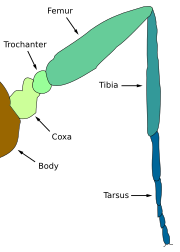Leg
A leg is a weight-bearing and locomotion device. Birds and humans have two legs, but many animals have four or six or even more. A biped is an animal with two legs and quadruped is an animal with four legs. Centipedes and millipedes have many more legs.


By extension, the word is also used for some objects. For example tables and chairs, also have legs to hold them up.
People also use the word "leg" in idioms, for example:
- you do not have a leg to stand on (that means "you have no support; you have no chance in this discussion")
- to leg it (to run)
- to pull someone's leg (to play a little joke on someone for fun by trying to make them believe something that is not true)
Components
changeA leg is a structure of gross anatomy, meaning that it is large enough to be seen unaided. The components depend on the animal. In humans and other mammals, a leg includes the bones, muscles, tendons, ligaments, blood vessels, nerves, and skin. In insects, the leg includes most of these things, except that insects have an exoskeleton that replaces the function of both the bones and the skin.
Sometimes the end of the leg, or foot, is considered part of the leg; other times it is considered separate. Similarly, the hip joint or other place where the leg attaches to the main body may be considered separate or part of the leg.
Robotic leg
changeA robotic leg is moved by an actuator, which is a type of motor for moving or controlling a mechanism or system. It is operated by a source of energy, usually in the form of an electric current and converts that energy into some kind of motion.
Prosthetic leg
changeA prosthetic leg is an artificial leg that is used to replace one that has been lost.